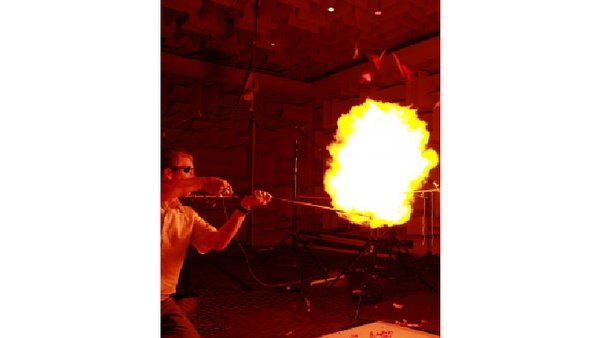Bombs and Balloons Burst onto the Research Scene
Oct. 4, 2012

BYU science classes might blow you away—literally.
Although exploding balloons might seem like just another distraction to keep students awake in science classes, they can also be used in serious scientific research. Recently, two BYU professors used exploding balloons to better understand how sounds like those created by other loud sources—rockets, military jets, bombs, and shotguns–travel around us.
“It’s fun science. You get to blow things up, and I don’t know how things get better than that,” Professor Kent Gee said with a smile. “But it’s also real science. There are questions there that no one’s ever explored before, which makes it even better.”
This research into exploding balloons actually began in an effort to ensure that chemical demonstrations in the classroom were safe. Chemistry professor Jeff Macedone approached Gee with the idea of determining just how loud blowing up hydrogen-oxygen balloons in a classroom can be and if the explosions might pose a danger to the students’ hearing.
This is a common classroom demonstration done throughout the world. When Gee and Macedone first did the experiment, they were shocked by how loud the explosions were. Gee, who studies acoustics, became worried about the auditory risks.
“With every single [blast], you are running some risk of suffering permanent hearing damage,” Gee said. Gee and Macedone were surprised at how little information was available on the auditory danger of these explosions and decided to study them more. Their results helped to change the way some classroom experiments were done.
However, the duo did not stop with their study of classroom demonstrations. During their experiments, Gee noticed that these explosions were acoustically similar to bomb explosions and other very loud noises. They realized that exploding balloons could be used as a new, safer way of studying these big booms.
“[Teachers] haven’t taken the time to properly record . . . the waves coming from these exploding balloons,” Gee said. “And once we took that step, all of the sudden, the applications opened up for us.”
The study of explosions is very important for the safety of soldiers and civilians around military jets, bombs, and shotguns. For example, hard body armor protects soldiers from the shrapnel of an explosion, but it isn’t doing such a great job protecting them from the intense shockwaves that may cause brain and lung damage.
Most research on the acoustics of explosions has traditionally used dangerous and expensive explosive material. Gee and Macedone decided to try using acetylene in oxygen, a safer and cheaper chemical alternative that welders use.
“What’s exciting about it is that we’ve pushed back some boundaries in a specific area of research,” Macedone said.
And has it been fun for the students and professors to explode these balloons?
“It’s an amazing experience to be there when an acetylene-oxygen balloon explodes. Imagine you’re just standing there and somebody just punches you square in the chest,” Macedone said.
By Curis Penfold, College of Physical and Mathematical Sciences
Photo courtesy of Drs. Gee and Macedone